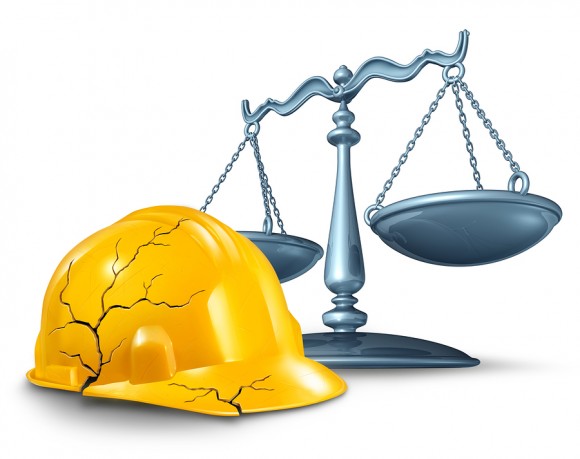The New York Committee for Occupational Safety and Health (NYCOSH) found in its latest construction fatality report that construction worker deaths are rising in New York, and many construction employers across the state are consistently violating regulations and code requirements.
The findings of the report, called Deadly Skyline: An Annual Report on Construction Fatalities in New York State, were revealed at City Hall on the same day that New York City Council introduced The Construction Safety Act, a legislation package of 18 bills calling for increased worksite safety and training programs in New York City.
“We need to take action now to end the crisis of rising construction fatalities in New York,” Charlene Obernauer, Executive Director of NYCOSH, said in a press release announcing the new report. “These deaths are almost always preventable and occur on non-union job sites 80% of the time.”
The report found that in the past two years alone, thirty workers have died in New York City’s construction sites, while nearly 500 construction workers’ lives have been taken in New York City sites in the past decade.
According to 2015 U.S. Bureau of Labor Statistics (bls) data, 49 percent of deaths in New York State and 59 percent of deaths in New York City were caused by falls, the report said. In NYCOSH’s analysis of all construction site inspections in New York State in 2014, it found more than 68 percent of site inspections revealed safety violations.
Additionally, safety violations were found at 87 percent of fatality sites inspected by the U.S. Occupational Safety and Health Administration (OSHA) in 2014, and more than 90 percent in 2015, the report said. Non-union construction sites were found in the report to be especially dangerous for workers.
Proposed Mitigation Strategies
In response to the report’s findings, the NYCOSH is calling for expansion of OSHA 10 training in order to more adequately educate and train all New York City construction workers. OSHA’s 10-hour construction safety training program provides workers with training on the most common hazards construction workers face on the job, but New York City currently only requires this OSHA 10 training for all workers on buildings 10 stories or larger or with footprints greater than 100,000 square feet, the report states.
The report also points to the expansion of legislative efforts as one opportunity to combat these challenges, as well as increasing the monitoring and enforcing of these laws. It advocates for preserving New York State’s Scaffold Safety Law, which protects construction workers by holding building site owners and employers liable for worker injuries and deaths resulting from unsafe conditions at elevated worksites, the report said.
Additionally, it supports passing the Construction Insurance Transparency Act, which requires insurers providing coverage for liability under the Scaffold Safety Law to publicly disclose information about premium determinations and financial solvency. The New York State Elevator Safety Act, which requires that design, construction, operation, inspection, maintenance, alteration and repair of elevators be done by licensed workers, is another piece of legislation that the report supports passing, adding that New York State should also initiate new legislation to establish penalties against contractors whose negligence leads to a construction workers’ death.
Construction Safety Act
The Construction Safety Act is one package of legislation that has been proposed by New York City Council to address some of these concerns as a direct response to the increase in construction worker fatalities and worksite regulatory violations in New York City.
“There is no other industry where workers die at such an alarming rate without significant preventative recourse,” said Council Member Jumaane D. Williams, Chair of the Housing and Buildings Committee, in a press release issued by New York City Council. “It is the responsibility of the developers and construction companies to ensure there is an atmosphere of safety at construction sites. The Construction Safety Act will help government do its part in ensuring this atmosphere of safety truly exists by reducing safety violations and strengthening crane regulations.”
The bill requires additional safeguards, such as more extensive guardrail and netting requirements, to help prevent falls at construction sites, the release states.
It also aims to create a more comprehensive system for tracking incidents and to ensure timely reporting of violations by the Department of Buildings (DOB) and OSHA by consolidating information from the two organizations while requiring that the DOB maintain a list of all construction-related injuries and fatalities, according to the release.
“The epidemic of construction worker deaths in New York City is in part a result of OSHA being grossly understaffed and overworked,” said Council Member Rory Lancman, Chair of the Committee on Courts and Legal Services, in the release. “We’re not going to end this crisis so long as the left hand and the right hand aren’t working together.”
The legislation package counts additional elements among its focus, such as increased penalties for code violations, a greater emphasis on safety education and plan implementation and requirements to better regulate crane safety at New York City construction sites based on recommendations from the City’s Crane Technical Working Group.
Councilman I. Daneek Miller pointed to the NYCOSH report as one factor New York City Council plans to take into consideration as it moves to increase construction site safety going forward.
“One fatality at a construction site is one too many, and the city should be doing everything in its power to ensure the highest standards of safety are met,” he said in the press release. “This report will help us develop ways to meet our goals.”
The NYCOSH is a membership organization of workers, unions, community-based organizations, workers’ rights activists, and health and safety professionals. NYCOSH uses training, education and advocacy to improve health and safety conditions in workplaces, communities and the environment.
Related:
- New York Forms Task Force to Probe Corruption in Construction Industry
- New York Court Examines Scope of Scaffold Law in 2 Injury Cases
- N.Y. Group: Scaffold Law Will Consume Billions from Public Projects Spending
- OSHA, State Probe New York’s Latest Crane Collapse
Topics New York Legislation Workers' Compensation Training Development Construction
Was this article valuable?
Here are more articles you may enjoy.



 FBI Says Chinese Hackers Preparing to Attack US Infrastructure
FBI Says Chinese Hackers Preparing to Attack US Infrastructure  Cargo Owners in Baltimore Disaster Face ‘General Average’ Loss Sharing, MSC Says
Cargo Owners in Baltimore Disaster Face ‘General Average’ Loss Sharing, MSC Says  Harvard Study Again Stirs the Pot on Demotech Ratings of Florida Carriers
Harvard Study Again Stirs the Pot on Demotech Ratings of Florida Carriers  California Chiropractor Sentenced to 54 Years for $150M Workers’ Comp Scheme
California Chiropractor Sentenced to 54 Years for $150M Workers’ Comp Scheme 


